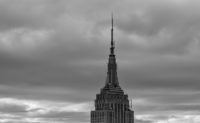On July 29, the Empire State Building unveiled a new visitor observatory experience and museum in Midtown Manhattan. The 10,000 square foot space—designed by Thinc, Beneville Studios, Corgan, IDEO, and Squint/Opera, among others—occupies part of the second floor of the Art Deco skyscraper. Exhibitions highlight the structure’s modern-day interventions, guiding visitors through its storied past and ultimately escorting them up to the 86th floor observatory. At 1,454 feet tall, the Empire State Building, designed by Shreve, Lamb and Harmon, was completed in 1931—and is now home to the Architectural Record offices.
The new visitor experience begins in a vestibule lined with the building’s early history and plans, opening into a room where an archival panoramic photograph of the original site (it housed the Waldorf-Astoria Hotel up through the 1920s) wraps the walls from floor-to-ceiling. Here, one can view imagined video clips of scenes of Midtown’s past through building surveyors. The building’s original survey marker is displayed in the center of the room.
But perhaps the most interesting of rooms is an immersive exhibit demonstrating the construction process. LED screens line the walls and part of the ceiling, displaying life-size videos—a mix of historical images and recreations—of workmen assembling steel beams that form the structure of the tower. Surround sound construction noise accompanies the video footage, creating an experience akin to what New Yorkers would have experienced at the site nearly 90 years ago. Glimpses of LED sky peek through openings in the wood-paneled ceiling meant to recall the scaffolding of construction zones past. At points during construction, as many as two floors were built each day, totaling only 14 months of construction time for the 102-story building.
Michael Benveille, chief creative officer of New York–based Beneville Studios says his firm wanted to bring a sense of “childlike wonder” to the observatory and museum, while still honoring the legacy and integrity of the building, “without making it too much like a theme park.”
The museum also contains models of the original Otis elevator cars, information on the building’s energy efficiency, and an exhibit on the Empire State Building’s place in pop culture, complete with historical artifacts, photos, and film clips. The project represents the second phase of an extensive, $165-million renovation plan, which began with a new observatory entrance, which opened on 34th Street last summer. The final pieces of the observatory’s face-lift will be completed next year.








Post a comment to this article
Report Abusive Comment